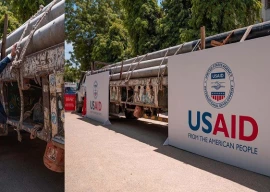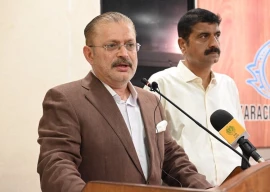
Spread over a radius of 4.5 to 6 kilometres are the ruins of Pari Nagar, a flourishing Jain town that had its own seaport circa 1st century BCE, the claims go.
A destination for archeologists, historians and travel writers, Pari Nagar boasts Jain temples, artifacts and sculptures, preserved for centuries, but are now on the verge of collapse.
The reason for decay? Phenomenal rains, chronic neglect.
While Tharparkar received an average rainfall of about 171 mm between 2001 and 2010, this year’s downpour was eight times that average.
And while platforms and tombs of dozens of temples are in ruins, some have survived the ravages of time, and these monsoons, including the Gorri Jo Mandar, Viravah temple, the temple of Bhoodeshar and the Jain temple in Nagarparkar town.
How long will they continue to stand, however, is a troubling question.
Gorri Jo Mandar
Ninety-feet long and 40 feet wide, Gorri Jo Mandar is located on a diversion towards east at the Nagarparkar-Mithi road.
“It starts with a dalan, a verandah open on three sides with curved arches,” reads a description from Raichand’s book, Tarikh-e-Registan (History of the desert). The author, however, is not sure about the type of material used in the construction.
From marble to sand stone and limestone, there is little consensus on what the temple is actually made of.
“Till now, there has been no scientific study about Gorri Jo Mandar’s material,” says Gulsher Mangi, a geologist.
But whether it is sandstone, limestone or marble, it has a tendency to decay, he says.
Multidimensional decay
Exposure to rain and elements erodes the stone, exposing the material’s natural pores and triggering various decay processes, says Mangi while giving a tour of the Gorri temple.
Rain water has entered the foundations of temples through broken roofs, walls and ventilators, weakening the structures.
And while natural ventilation – sunlight and air – would easily dry the temples, the sheer amount of water this time around, needs additional help. And it’s fairly obvious, given the plants sprouting from nooks and crannies.
Rain water’s presence in the gaps in stone facilitates growth of fungi and other micro-organisms, thereby leading to a multidimensional decay process, says Muhib Laghari, a professor of geography at University of Sindh.
‘Offensive’ restoration
Last year, the Sindh government’s department of antiquities initiated the conservation project of Jain temples at Nagarparkar. The workmanship is visibly sub-par.
Patchwork, using ordinary bricks, sticks out sorely against the ancient temples’ surfaces.
“Before conservation work, it is imperative to study the material of the building which is being conserved,” says GM Shar, professor at the archeology department at Shah Abdul Latif University.
“If the material used in conservation is markedly different from the original material, it is offensive and unethical,” he says.
Teenaged temple looters
Natural elements aren’t the only threat to these ancient temples. Each monsoon brings with it intrusive teenagers from Thar’s villages, who dig through exposed platforms to collect ornamental stones and any object of visible value.
The threatening notice at the temples’ entrance falls on deaf ears: “Any person who destroys, damages, alters, disfigures, or scribbles … shall be punished with a rigorous imprisonment, which may be extended to three years, or fine, or both.”
Inside, the defacers have done all of the above, with impunity.
“This happens because the government-appointed custodians don’t perform their duties,” says Dr Ashok, head of the tourism development section of the Thardeep Rural Development Programme.
The ditzy tourists don’t help either.
“The monsoon season attracts thousands of tourists, who usually visit in groups, and damage the crumbling structures due to their insensitivity,” Ashok says. To the urban tourist, Manro Bhell, the lone worshiper at Gorri Jo Mandar, has a message: “Scared places are like humans; they need respect and compassion.”
The writer works in development with the Thardeep Rural Development Programme in Mithi and can be reached at junejozi@gmail.com
Published in The Express Tribune, October 3rd, 2011.
COMMENTS (4)
Comments are moderated and generally will be posted if they are on-topic and not abusive.
For more information, please see our Comments FAQ







































these temples are not 30 kilometers away from mithi town, how this unauthenticated information is published !!! shocked to see this unauthenticated information..
Internaional organization should explore the ancient wealth and culture of Thar. Congratulations to the Author for this informative report.
why should the islamic republic fund nonmuslim structures?